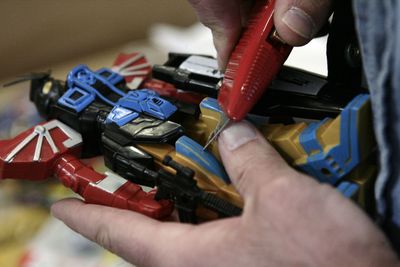New toy safety rules have retailers scrambling

NEW YORK – Toy stores across the country scrambled Monday to abide by tough new lead and chemical standards for toys that go into effect today.
Many toy sellers pulled questionable items off their shelves after a judge last week nixed a delay that would have given them a 12-month reprieve. The abrupt change and the lack of guidelines has left many retailers bewildered.
At The Toy Store in Atlanta, owner Denis Hofstetter was pulling about 5 percent of his inventory off the shelf on Monday just because he isn’t certain whether or not the toys conform to the regulations.
“It’s a great law that’s being implemented terribly,” said Hofstetter, 34.
Last summer, Congress passed the Consumer Product Safety Improvement Act, imposing tough standards for lead and certain chemicals, called phthalates, in products for children age 12 and under.
The standards were set to go into effect today, but on Jan. 30 the Consumer Product Safety Commission issued a one-year stay of enforcement for some testing and certification requirements for manufacturers and importers of regulated products. The decision gives the CPSC more time to finalize four proposed rules that could exclude some materials and products from testing and issue more guidance on how testing is to be conducted.
But retailers are still not allowed to sell the products, causing some uncertainty.
About a month ago, Hofstetter began contacting suppliers to make sure the products he received were compliant with the new regulations. He is taking a “conservative” approach to any toys that he cannot verify meet the new standards.
“Today we are pulling items off shelves that we are not comfortable with,” he said. “It’s very confusing. I want to comply with the law, but I’d like to know how.”
Hofstetter said he is removing metal toys that are painted, children’s jewelry and dress-up clothing with plastic sequins if they don’t have a certificate of conformity with the new standards from the manufacturers.
Katherine McHenry, 36, owner of Building Blocks Toy Store in Chicago, said she has contacted all of her vendors and feels confident that her selection of specialty toys meets the requirements. But she still feels uncertain if she knows enough about the regulations and plans to attend a safety seminar at the Toy Industry Association’s annual Toy Fair on Monday.
“I’m very happy to know that there’s going to be some type of standardized way for parents to feel like there’s a lot more involvement,” she said. “What I’m most disappointed in is that it all is happening so fast. Even myself, I don’t know what’s true and not true.”
Larger manufacturers and retailers have been tightening their own standards since Mattel Inc., the largest U.S. toy maker, in 2007 recalled more than 20 million toys made in China over fears of lead paint contamination and tiny magnets that children could accidentally swallow.
Hasbro Inc. says its products have been in line with the tightened regulations for several years, and major retailers such as Toys R Us say they already meet the new regulations.
“We believe we will be fully compliant when the new law goes into effect tomorrow,” said Toys R Us spokeswoman Kathleen Waugh.
Wal-Mart Stores Inc. and Target Corp. also said they would be compliant with the new regulations by today. They said they had been working with vendors to ensure toys met the rules but declined to say whether or when they had pulled any toys off their shelves.
But small retailers are left scratching their heads and, for products that can’t immediately be verified, using their best judgment of what to take off their shelves.
Allen Rickert, 56, owner of Top Ten Toys in Seattle, says he thinks toy safety regulations should be improved. He even spent $5,000 last year to have some of the toys he sells tested with an X-ray device to make sure they are safe.
“I want improved regulations; I think the regulations and enforcement we had was inadequate,” he said. “However, overly broad regulations – without reasonable exceptions – only hurt small manufacturers and small retailers.”
With the new regulations he is in the position of trying to guess if his products are safe enough in some cases, and in other cases is relying simply on the word of manufacturers.
“One of the things I’ll be doing today is wandering around trying to make a guess whether or not something might have something bad on it,” he said.